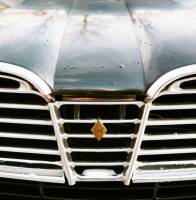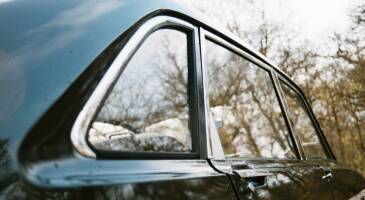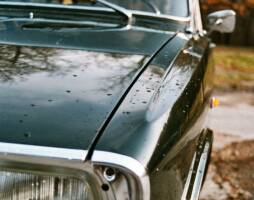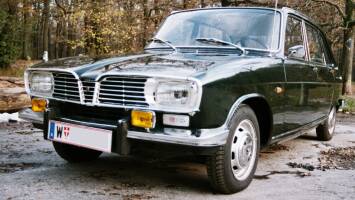
Why R16? Technical My sweet sixteen Interactive Links Home
The design of the Renault 16
The degin quality of the R16 shows often at the second glance. Not only the R16 stands out of the unit pulp of the now produced cars, but had little comparable in his time.
Let´s focus on some design specialities, besides of the conception:
The R16 is arched to the inside
Sounds weird? But that´s what it is. The R16 has a lot of surfaces arched to the inside. The most remarkable one in on the hood - a deep line, going through the total length of the hood and flows into a rectangle that gives the grille a special note. This rectangle was also introduced at themodels 6 and 12 in the extension, but left away totally lateron - even the R16 TX had the line in the hood, but the rectangle in the grille was missing. This inverted line was the against pole to the arches that grew exubertantly out of the hoods of US-american "muscle cars", showing power. This design element was made possible due to the fact, that the engine is located behind the front axle, and therefore no space is needed in the engine bay. This line continues as well on the roof, but not on versions with sunroof.

Another remarkable arch to the inside passes on the side of the car, from the front wing edge along the windows to the c-column, where it goes up along the third side window and vanishes in the roof line. The door handles, outstanding on other cars of this time, are integrated in this arch, giving the side line a very elegant inpression.


Another arch to the inside is located around the rear window. Due to this feature, the window is more upright than the roofline, a feature that could be found even at the VW Golf I, where it is outlined in black colour.
The vertical surfaces of the bumbers in front and at the rear are arched to the inside.
Finally, at models with conventional headlights, the glass surfaces are ached to the inside. Investigations at Renault resulted with the conclusion that concave lamp glasses become less dirty. In my opinion, these investigatons weren´t worth the money - these glasses get as dirty as normal ones...
The R16 has an unique roofline!
The R16´s roofline is very prominent: at the front egde two elevations emerge out of the roof which line along the roof side to go down aside the rear cargo door. This line is pronounced by two massive chrome rails which lead to the edge of the rear door. The actual roof area is locted within these two elevations, so it develops a pagode like form; this line goes down along the rear door and also borders the rear screen, whereas this end is very remarkable, with the already mentioned arch to the inside around the rear screen. This construction had a reason: in the sixties, car were constructed on the drawing board, without computer support. At Renault there was the fear that without the static reinforcement in the area of the rear seats, combined with the long, flat hood, the body could become instable. Therefore, the sidewalls and the roof structure had been made especially strong. Side effect: due to the fact that no water could float over the doors from the roof, the R16 has no gutters - nowadays standard.

"Actually, the R16 isn´t a beautyful car!"
That is what I had heard sometimes : It´s true, the R16 isn´t a "classic" Beauty like the DS or a BMW-Coupé. The front has a "rejecting look", as well as the rear, which was redesigned at the first facelift. Till today I am not quite sure what is most fascinating for me on the R16. The inclinated winows make the impression a bit old-fashioned, the hatchback has a quite progressive look. Problably it´s the mixture, that makes the sharp charme of the R16 design that unique.
The R16 - a chrome monster?
Like the most cars of the sixties, on the R16 isn´t attached few chrome applications - at least at the first versions, related to modern times. Contemporary ads lined out "a clear appearence and a renunciation of unnecessary chrome" - a joke, when you look at the first versions. The grille, the bumpers, the window enclosures, the rails on the roof an below the doors, the door handles, the end rail of the rear door, the wipers, the mirrors, the badges on the side walls... chrome, chrome, chrome. Nowadays a feast for the eye, normal in the sixties.

In the seventies, chrome disappeared year after year, which made a different impression. The finally presented top model, the R16 TX, had a lot of black applications inidacting the sporty spirit of this time: mirrors and wipers for example, or inside, the enclosures ot the instruments at the last versions. The end rail of the rear door mutated to black with the facelift 1971. The grille of the TX was quite different to the old chrome grille, incorporating grey plastic with fine chomre ends. On the oter hand, the TX had some chrome details that were missing at the other versions: first, it hat chrome rails around the wing cutouts, and then, very remarkable, a chrome wing reaching over the whole width of the roof - the first roof spoiler on a hatchback! The badges on the rear sidewall loosed parts an disappeared finally 1974. From 1975 on, a plastic grille was used on all models, black on the smaller L-TS models. This black grille makes a totally different "face", and especially these types with the black plastic grille are disappearing. Many R16 drivers like the chrome grille more, and therefore on meetings there are only very few "black ones".